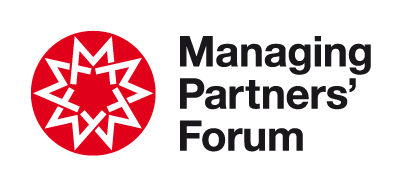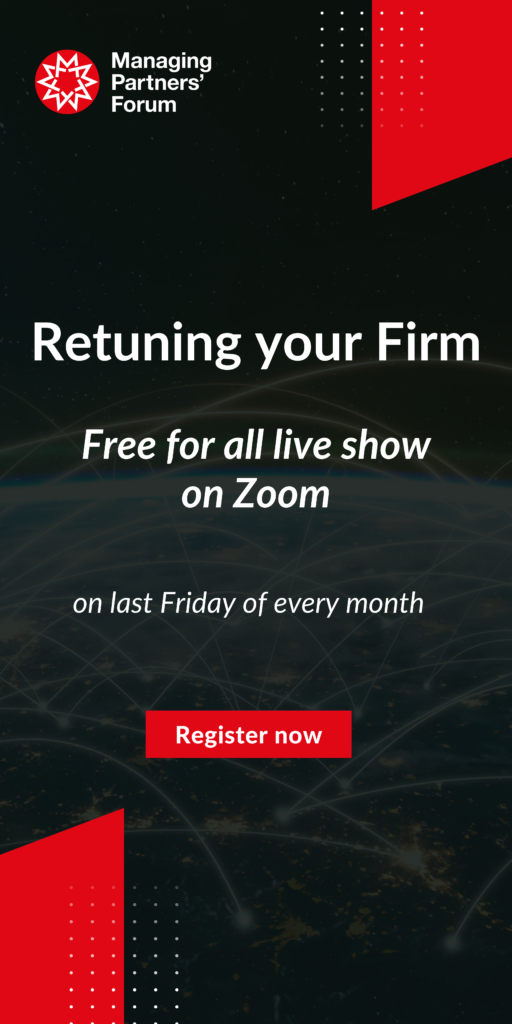Managing Partners’ Forum’s MTT meeting, hosted by Gerald Eve, covered how an organisation’s core purpose drives its strategy and improves profitability by engaging its people and boosting their performance. It featured a case study led by Christopher Grove, corporate finance partner and head of transaction services at BDO and chair of the firm’s ‘U Board’ which was set up with the purpose of unifying its culture. Anita Harris, managing partner at consultancy Sheppard Moscow, facilitated BDO’s core purpose initiative. Presentations were followed by a panel discussion with questions from attendees moderated by Fay Gillott, former CEO at Atkins Chambers and 7 Bedford Row, and director at Lovells (now Hogan Lovells).
Grove opened the session with a quote from Simon Sinek, “People don’t buy what you do, they buy why you do it” as the rationale for developing and delivering the project.
Core purpose is an organisation’s fundamental reason for existing and the driver behind its business model and strategy. But while the latter will change over time, core purpose should remain consistent, as it underpins long-term competitive advantage. Research shows that organisations with a clearly defined core purpose outperform their markets.
For example, Marriott and Hewlett Packard are businesses whose success is predicated on sticking rigidly to a core purpose that defines what they do – and what they don’t do.
McKinsey’s core purpose is to help leading organisations and governments be more successful; Merck’s is to improve and preserve human life; and Disney’s is to make people happy.
As Grove explained, a company’s core purpose is distinct from its strapline, slogan or mission statement which will change in response to external markets. McKinsey’s strapline is ‘Everything can be measured, and what measured gets managed’; Merck’s is ‘Investing for life’ and Disney regularly changes its straplines, such as ‘The magic kingdom’, ‘The happiest place on earth’ and ‘Where dreams come true’. Where straplines are external-facing, core purpose engages the firm and its employees in a shared overarching objective.
Focusing on core purpose improves profit – by boosting employee engagement. Research conducted by Towers Watson in 2010 found that companies with a highly engaged workforce improved their operating income by 19.2% over 12 months, while companies with low engagement experienced a 32.7% decline in operating income over the same period.
In 2015, Groves joined his fellow on an executive business course at Saïd Business School which included a scenario planning exercise looking at organisations’ challenges over the following three to five years. They identified BDO’s biggest challenge as culture.
“We needed to rediscover our core purpose, the essence of our company that has held us together through recession, growth and massive organisational change,” said Groves. “When I proposed the project to the then managing partner, he asked how long this would take, and how much it would cost, and I had to explain that this was a journey, so the parameters were unclear. None the less, he supported it.”
Managing director Anita Harris explained that Sheppard Moscow uses core purpose as a vehicle for building engagement in partnership organisations. “As professional organisations are becoming more corporate, they are losing the sense of identity that partnership brings. Sheppard Moscow sometimes finds itself pitching against brand agencies, but core purpose is very different from branding. It is not about rebranding or creating something new. Rather it is about identifying the organisation’s identity – the essence that differentiates it in the marketplace and engages its employees and stakeholders – and this can be blurred by multiple mergers.”
Groves described BDO’s core purpose journey as peeling the organisational onion. “We had gone through a lot of organisational change and restructuring over the years, including mergers, acquisitions and lateral hires. Although much of our M&A activity involved organisations whose core purpose was similar to ours, we wanted to wipe away the residue of change and recapture the essence of BDO.”
Groves’ own lightbulb moment occurred when a lateral hire asked him what had kept him working at BDO for over 20 years, and his response was about its culture and values. He remembered how when he joined the firm in the 1990s, the partnership pulled together to get through tough times. For that reason, he was wary of entrusting the project to external consultants – the business needed to own it in order to fully engage with it. He describes Sheppard Moscow as the guardians of BDO’s core purpose journey.
Harris worked in close partnership with the project steering group, the partners who had attended Saïd Business School. “It was important to create something that the partners believed in, before involving the wider organisation,” she explained. “We worked with the steering group to create a path towards a collective core purpose that combined freedom and entrepreneurship. We then ran a series of voluntary workshops for groups of about 20 partners. About 50% of partners chose to participate.”
The process was based on the Jim Collins hedgehog concept, from his book Good to Great. It relates to the intersection of three focus areas:
- What you are deeply passionate about
- What you can be best in the world at, and
- What best drives your economic or resource engine
Put simply, the hedgehog concept is about getting organisations and individuals to understanding what they can be best at – and that is your core purpose.
Workshop participants started by identifying their individual hedgehogs: what are they personally passionate about; what do they excel at (i.e. what distinguishes them in their role), and how do they contribute to the organisation? Groves identified the economic engine as a sticking point – how do people’s passions and skills convert to their contribution to the economics of the business This produced revelations between colleagues, many of whom discovered shared individual drivers and motivations.
Each cohort then built a collective hedgehog for BDO. This uncovered a lot of common ground, especially around what drives and motivates people. Groves, highlighted the power of the process – so long as everyone approaches it with a positive mindset. “Part of the challenge is interpretation, but once we started peeling away the job titles, we found we had a huge amount of commonality, which probably explains why we all had stayed at the firm for so long: our core purpose was binding us together.”
BDO has since adopted the ‘hedgehog’ model into other internal processes, including career development and appraisals. “It is a hugely simple model, but deep if it is applied in the right way,” observed Groves. “The core purpose journey encouraged partners to engage with each other in the business. We were understanding each other as human beings, beyond being colleagues and partners, which added a new dimension to working relationships.”
Harris and her team worked with the steering group to review the collective hedgehogs created by the workshops with a view to producing a value statement that would resonate with internal and external stakeholders. This included identifying and reconciling the various alignments and tensions across business.
Core purpose meant getting away from terminology to create an authentic representation of the essence of the business. The key challenge was that various departmental and regional cultures interpret stories and concepts differently. As Groves explains, core purpose is like a stick of Brighton rock – each piece may have different colours and flavours, but they all have a common theme running through them. “We needed to create something that would engage all the microcultures around the business, beyond the vocabulary.”
When the steering group presented the themes at staff workshops across the country, some of the ideas were described as aspirational rather than reflecting reality. “There will always be gaps between aspirations and what is happening on the ground,” said Groves. “There was some candid feedback, but in general, there was agreement across the business. We then went through a series of iterations – it’s not about the words; it’s about the meaning.”
Ultimately, BDO’s core purpose was distilled down to ‘Helping people succeed’. “But that didn’t quite work because it was not sufficiently personal,” explained Groves. “People were asking, ‘What should this mean for me personally?’ So, we changed it to ‘Helping you succeed’.”
Core purpose is a continuous process and defining the ‘essence of the firm’ was what Groves described as “the end of the beginning” for BDO. “The next stage of the journey is to build our strategy around that cornerstone,” he added. So far, this has included bringing BDO’s clients into the process, and the first client they asked for feedback was Sheppard Moscow! However, it is important to recognise that defining an organisation’s core purpose is not about external communication; rather it is about engaging and galvanising the workforce, which then changes the way in which people engage with its clients.
“Core purpose is about authenticity first,” says Groves, “and that affects how we work with our clients, how we develop business and how we recruit and retain our people – it is about creating a culture that resonates with all our stakeholders.”
Joanna Goodman

